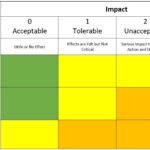Broadly speaking, a businesses’ risk can be grouped into three large categories – Operational Business Risk, Financial Business Risk, and Governmental Business Risk. This post will focus on operational business risk, and a future post will look at financial and governmental business risks.
We can all agree that some business ventures are inherently riskier than others. A product-based business focused on a new product in a brand-new category is far riskier than, say, a service-based cleaning company that operates in an established service category. Small business risk comes in many different forms. Some you’ll be able to prepare for, and there are others you can’t.
A PESTEL analysis allows a business to consider macro-environmental conditions, while Porter’s Five Forces allows a business to consider the micro-environmental forces that can alter the risk profile of a business.
That said, it is always a good idea to review your risk exposure from time to time and develop a plan to deal with anything that comes up before you are forced to deal with them during a crisis.
Operational Business Risk Defined
Operational business risks are failures related to day-to-day operations that can impede a company’s ability to earn revenue. Often operational business risks are the result of insufficient or failed processes. An example of a few operational business risks might be:
- A clogged toilet in your restaurant necessitates that the business closes until it gets it fixed.
- Your web hosting company goes offline for several hours making access to your company’s e-commerce site unavailable, thereby causing you to lose sales.
- The flu epidemic hits your business, resulting in high absenteeism and causes the company to miss a deadline.
Operational business risk can be broken down into seven types of risks.
Strategic Risk
Strategic risk is where a business has risk associated with taking on or changing the businesses strategy direction. Strategic risk involves the owner weighing the pros and cons of taking the business in a new direction. Here are three common examples of strategic risk.
- You have a successful business in one part of town. You are thinking about opening a second location across town to grow your business. Will this new location add to your already successful business or cause you to fail?
- You have outgrown your current physical space requirements. You are considering signing a new lease on a much larger space which may provide growth options for you in the future. Will moving to a much larger space increase your operational capacity or will the increased rent cause more financial risk
- You spot a product that you think will sell well in your store. You agree to buy the product in bulk, lowering your per-product cost and providing you with more margin. Will the product sell as fast as you projected or will you have to heavily discount it just to get a portion of your invested money back?
Reputation Risk
Reputation risk is where the company’s reputation is tarnished as a result of an incident perceived as being dishonest, disrespectful or incompetent. Reputation risk is generally associated with a serious loss of trust or confidence in your business.
Here are three common examples of reputation risk.
- An employee has their laptop stolen that contains sensitive client information.
- A customer has a bad experience with your business. Rather than addressing the customer’s issue, the owner defends the company’s actions and the customer leaves a negative review about your establishment that goes viral.
- An employee is overheard speaking ill about a client. An employee of the client firm takes out their phone and records the discussion. A few days later, the company and the owner are hit with a lawsuit claiming slander.
Quality Risk
Quality risk is where you fail to meet the quality goals of your products, services and/or business practices. You don’t need to be the manufacturer of the goods or the person delivering a service to be affected by quality risk.
If you sell a product that does not meet the customers; quality expectations, the customer will hold the retail business accountable for any injury or damages.
Moreover, your business may use a subcontractor whose potion of the project fails to meet the customers’ expectations. The customer will not hold the subcontractor accountable, but instead hold your business responsible.
Resource Risk
Resource risk is where a lack of resources, including both human and financial, can cause a business to fail to meet its objectives.
For example, your customer says that your video production company did a great job on a recent promotional video. Now they what you to handle all of their video production needs. Can you find enough videographers and video editors to support this new work? Do you have the financial resources available to purchase the necessary new equipment to support the increased workload?
As a business grows it often needs more employees. With more employees comes greater risk. Studies have shown that employee turnover can cost a company 150% of the employee’s annual salary to replace. Additionally, when a company has non-owner employees, there are a huge number of employment laws that the business needs to be aware of and follow. These laws can be both federal and state level. Most states also require that you buy workers’ compensation insurance to protect employees against workplace injuries.
Seasonal Risk
Seasonal risk is where a company’s revenue is concentrated in a single season. For example, a landscaper is very busy in the summer months, whereas the winters are lean. Similarly, a ski rental business is very busy in the winter but the summers are very lean.
Structure Risk
Structure risk is where the location of the business, be it a home office or in a commercial property, can suffer damage. Here are three common types of structure risks.
Infrastructure – Is the premise in a high crime neighborhood? Is it secure?
Natural Disaster – Is the premise in a floodplain, hurricane or earthquake zone?
Fire – Is the premise’s construction, for example wood siding, making it more prone to fire? Could something like a nearby wildfire, and the subsequent effects such as flooding impact business operations?
Contract Risk
Contract risk is where the business may be forced to live up to the fine print in a contract or fail to be able to hold a vendor or customer accountable.
Contracts can be complicated and are not something that is directly billable. Therefore, contracts are often overlooked by many small business owners. Starting a project just based on a handshake agreement is risky. Verbal contracts, while technically legal, are difficult to enforce and boil down to what he said vs what she said. While verbal contracts are appropriate in some situations, a written contract is definitely more robust and more likely to stand up in court if there are any disputes.
When entering into a contract with a large company, these companies will almost always have you sign their contracts. Failing to read the fine print may put a business at risk.
The bigger the business, the bigger the risk. As a business grows, it is more likely to work with other companies such as a marketing or social media companies. Be sure to read the fine print in all contracts. When in doubt, have your lawyer check it out.
In the next post, we’ll look at Financial and Governmental Related Risks your business may face so you can consider ways to mitigate the effects if things go wrong.
Have you considered how you will respond to operational business risk?












